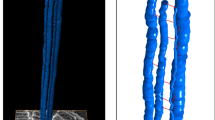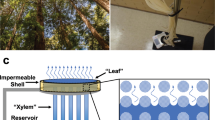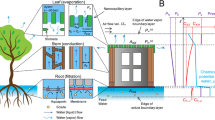Abstract
DESPITE two centuries of research, the mechanism of water transport in plants is still debated1–8.The prevailing cohesion–tension theory2,3, which states that water is pulled upwards by capillarity in cell-wall pores, remains vulnerable to challenge because its corollary is difficult to prove: that large negative pressures exist in xylem conduits4–7. Recent xylem pressure-probe and z-tube experiments suggest that cavitation limits xylem pressures to above −0.5 MPa, despite the much more negative pressures predicted by the cohesion–tension theory and measured with the standard pressure-chamber method4,5,9,10. Here we show, using centrifugal force to induce negative pressure between −0.5 and −3.5 MPa in intact stems, that xylem conduits remained water-filled and conductive to species-specific pressures ranging from −1.2 to below −3.5 MPa. Results were consistent when stems were air-dried or injected with air. Agreement among these techniques demonstrates that xylem can support large negative pressures, that the pressure chamber reliably measures these pressures, and that cavitation is nucleated by air entry through conduit wall pores.
This is a preview of subscription content, access via your institution
Access options
Subscribe to this journal
Receive 51 print issues and online access
$199.00 per year
only $3.90 per issue
Buy this article
- Purchase on Springer Link
- Instant access to full article PDF
Prices may be subject to local taxes which are calculated during checkout
Similar content being viewed by others
References
Hales, S. Vegetable Staticks (W. & J. Inneys and T. Woodward, London, 1727).
Dixon, H. H. & Joly, J. Phil. Trans. R. Soc. Lond. B 186, 563–576 (1895).
Pickard, W. F. Prog. Biophys. molec. Biol. 37, 181–229 (1981).
Zimmermann, U. et al. Pl. Cell. Envir. 17, 1169–1181 (1994).
Smith, A. M. Ann. Bot. 74, 647–651 (1994).
Canny, M. J. Ann. Bot. 75, 343–357 (1995).
Canny, J. J. A. Rev. Pl. Physiol. molec. Biol. 46, 215–236 (1995).
Sperry, J. S. et al. Pl. Cell. Envir. (in the press).
Zimmermann, U. et al. in Water Deficits: Plant Responses from Cell to Community (eds Smith, J. A. C. & Griffiths, H.) 87–108 (Bios, Oxford, 1993).
Zimmermann, U., Haase, A., Langbein, D. & Meinzer, F. Phil. Trans. R. Soc. Lond. B 341, 19–31 (1993).
Oertli, J. J. Z. Pflanzenphysiol. 65, 195–209 (1971).
Apfel, R. E. Scient. Am. 227, 58–71 (1972).
Green, J. L. et al. Science 249, 649–652 (1990).
Temperley, H. N. V. Proc. phys. Soc. 59, 199–208 (1946).
Fisher, J. C. J. appl. Phys. 19, 1062–1067 (1948).
Trevena, D. H. The Liquid Phase (Wykeham, London, 1975).
Trevena, D. H. Am. J. Phys. 47, 341–345 (1979).
Tyree, M. T., Davis, S. D. & Cochard, H. Int. Ass. Wood Anat. J. 14, 335–360 (1994).
Briggs, L. J. J. appl. Phys. 21, 721–722 (1950).
Smith, A. M. J. exp. Biol. 157, 257–271 (1991).
Yang, S. & Tyree, M. T. Pl. Cell Envir. 15, 633–643 (1992).
Sperry, J. S. & Tyree, M. T. Pl. Physiol. 88, 581–587 (1988).
Scholander, P. F., Hammel, H. T., Bradstreet, E. D. & Hemmingsen, E. A. Science 148, 339–346 (1965).
Zimmermann, M. H. Xylem Structure and the Ascent of Sap (Springer, Berlin, 1983).
Sperry, J. S. & Saliendra, N. Z. Pl. Cell Envir. 17, 1233–1241 (1994).
Holbrook, N. M., Burns, M. J. & Field, C. B. Science (in the press).
Murphy, R. & Smith, J. A. C. Pl. Cell. Envir. 17, 15–29 (1994).
Sperry, J. S. & Tyree, M. T. Pl. Cell Envir. 13, 427–436 (1990).
Jarbeau, J. A., Ewers, F. W. & Davis, S. D. Pl. Cell Envir. 17, 695–705 (1994).
Sperry, J. S., Donnelly, J. R. & Tyree, M. T. Pl. Cell Envir. 11, 35–40 (1987).
Author information
Authors and Affiliations
Rights and permissions
About this article
Cite this article
Pockman, W., Sperry, J. & O'Leary, J. Sustained and significant negative water pressure in xylem. Nature 378, 715–716 (1995). https://doi.org/10.1038/378715a0
Received:
Accepted:
Issue Date:
DOI: https://doi.org/10.1038/378715a0
This article is cited by
-
Extreme thermodynamics in nanolitre volumes through stimulated Brillouin–Mandelstam scattering
Nature Physics (2023)
-
Non-contact optical characterization of negative pressure in hydrogel voids and microchannels
Frontiers of Optoelectronics (2022)
-
Neue Methoden ermöglichen die Live-Beobachtung der Holzentstehung
BIOspektrum (2022)
-
How does the Cucurbitaceae family take up organic pollutants (POPs, PAHs, and PPCPs)?
Reviews in Environmental Science and Bio/Technology (2021)
-
Leaf phenology and morphofunctional variation in Myrcia amazonica DC. (Myrtaceae) in gallery forest and “campo rupestre” vegetation in the Chapada Diamantina, Brazil
Brazilian Journal of Botany (2017)
Comments
By submitting a comment you agree to abide by our Terms and Community Guidelines. If you find something abusive or that does not comply with our terms or guidelines please flag it as inappropriate.



